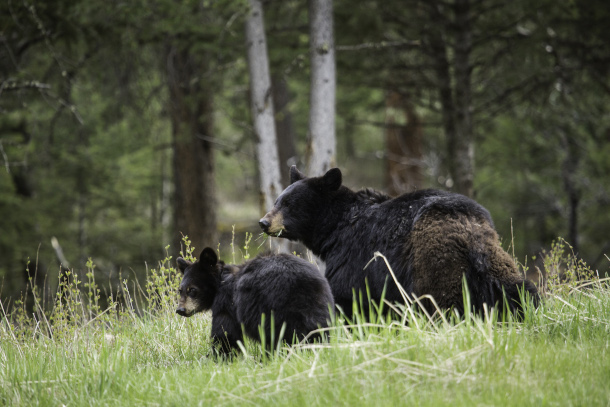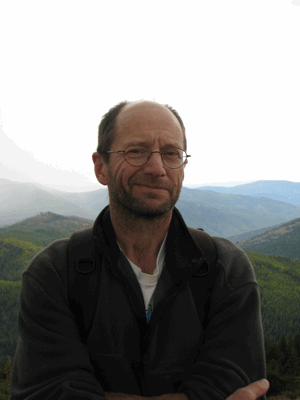Spring Awakening
Air Date: Week of April 9, 2021

A black bear sow and her cub walk through Tower Fall in Yellowstone National Park on a May afternoon. (Photo: Neal Herbert, National Park Service, Flickr, Public Domain)
Montana-based writer Rick Bass shares the stories of playful grizzly bears coming out of hibernation as winter melts away into spring.
Transcript
CURWOOD: It’s Living on Earth I’m Steve Curwood
Writer Rick Bass lives in the Yaak Valley of Northwest Montana. He says there is a point in the spring when sleep gives way to rambunctious wakefulness, where winter has truly left and won’t be coming back for many months.
BASS: The snow is melting. The grizzly bears that have been sleeping beneath the snow, suspended like seeds, will prowl the warm fields just beneath the snow, grazing on the delicious emerging lilies. Sometimes the yellow pollen gets caught on the fur and snouts of the great golden bears as they grub and push through the lily fields, pollinating other lilies in this manner. In this crude fashion, they are farmers of a kind, nurturing and expanding one of the crops that first meets them each year. The lilies follow the snow, and the snow pulls back to reveal the bears, and the bears follow the lilies. The script of life begins moving with enthusiasm once again, a script and a story more exuberant than any that has been seen so far this year.

Rick Bass is a Montana-based writer and environmental activist. (Photo: Courtesy of Rick Bass)
And on winter’s remnant glistening ice shields, which grow smaller every day, the grizzly mothers with their cubs slide down the slopes on their backs. They ride the ice to the bottom, cartwheeling into fields of lilies, resting at the bottom of the vanishing glacier, and then climb right back up to the top. They slide and play for hours at a time, safely distanced from the new and changing world that lies along the river bottoms and in the lower elevations where people live. There is nothing but joy and new wakefulness running through their blood.
And though there are none of us who can tell by a certain murmuring of our own blood, when it is exactly that the bears climb back up out of the earth, I like to think that the other creatures of the forest can sense it. As easily as we might hear and feel the warming south winds moving through the tops of the pines. I like to think, too, that that joy is as transferable as felt and connected among all the inhabitants of the forest, as are the south thawing winds upon the land and upon and among all of us.
CURWOOD: Rick Bass lives and writes in the Yaak valley, in Montana. This snapshot of bears and lilies at the end of winter comes from his book, The Wild Marsh.
Links
Living on Earth wants to hear from you!
Living on Earth
62 Calef Highway, Suite 212
Lee, NH 03861
Telephone: 617-287-4121
E-mail: comments@loe.org
Newsletter [Click here]
Donate to Living on Earth!
Living on Earth is an independent media program and relies entirely on contributions from listeners and institutions supporting public service. Please donate now to preserve an independent environmental voice.
NewsletterLiving on Earth offers a weekly delivery of the show's rundown to your mailbox. Sign up for our newsletter today!
 Sailors For The Sea: Be the change you want to sea.
Sailors For The Sea: Be the change you want to sea.
 The Grantham Foundation for the Protection of the Environment: Committed to protecting and improving the health of the global environment.
The Grantham Foundation for the Protection of the Environment: Committed to protecting and improving the health of the global environment.
 Contribute to Living on Earth and receive, as our gift to you, an archival print of one of Mark Seth Lender's extraordinary wildlife photographs. Follow the link to see Mark's current collection of photographs.
Contribute to Living on Earth and receive, as our gift to you, an archival print of one of Mark Seth Lender's extraordinary wildlife photographs. Follow the link to see Mark's current collection of photographs.
 Buy a signed copy of Mark Seth Lender's book Smeagull the Seagull & support Living on Earth
Buy a signed copy of Mark Seth Lender's book Smeagull the Seagull & support Living on Earth

